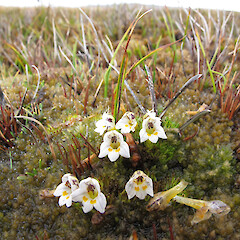Euphrasia dyeri
Common name
creeping eyebright
Family
Orobanchaceae
Flora category
Vascular – Native
Endemic taxon
Yes
Endemic genus
No
Endemic family
No
Structural class
Herbs - Dicotyledons other than Composites
NVS code
The National Vegetation Survey (NVS) Databank is a physical archive and electronic databank containing records of over 94,000 vegetation survey plots - including data from over 19,000 permanent plots. NVS maintains a standard set of species code abbreviations that correspond to standard scientific plant names from the Ngä Tipu o Aotearoa - New Zealand Plants database.
EUPDYE
Current conservation status
The conservation status of all known New Zealand vascular plant taxa at the rank of species and below were reassessed in 2017 using the New Zealand Threat Classification System (NZTCS) – more information about this can be found on the NZTCS website. This report includes a statistical summary and brief notes on changes since 2012 and replaces all previous NZTCS lists for vascular plants.
Please note, threat classifications are often suggested by authors when publications fall between NZTCS assessment periods – an interim threat classification status has not been assessed by the NZTCS panel.
- Conservation status of New Zealand indigenous vascular plants, 2017 . 2018. Peter J. de Lange, Jeremy R. Rolfe, John W. Barkla, Shannel P. Courtney, Paul D. Champion, Leon R. Perrie, Sarah M. Beadel, Kerry A. Ford, Ilse Breitwieser, Ines Schönberger, Rowan Hindmarsh-Walls, Peter B. Heenan and Kate Ladley. Department of Conservation. Source: NZTCS and licensed by DOC for reuse under the Creative Commons Attribution 4.0 International licence.
2017 | Not Threatened
Previous conservation statuses
2012 | Not Threatened
2009 | Not Threatened
2004 | Not Threatened
Distribution
Endemic. South and Stewart Islands, Mountains of northwest Nelson (Mount Gouland), Otago, Southland and Stewart Island; Mount Somers, Canterbury.
Habitat
Montane bogs up to 1500m a.s.l.
Wetland plant indicator status rating
Information derived from the revised national wetland plant list prepared to assist councils in delineating and monitoring wetlands (Clarkson et al., 2021 Manaaki Whenua – Landcare Research Contract Report LC3975 for Hawke’s Bay Regional Council). The national plant list categorises plants by the extent to which they are found in wetlands and not ‘drylands’. The indicator status ratings are OBL (obligate wetland), FACW (facultative wetland), FAC (facultative), FACU (facultative upland), and UPL (obligate upland). If you have suggestions for the Wetland Indicator Status Rating, please contact: [Enable JavaScript to view protected content]
OBL: Obligate Wetland
Almost always is a hydrophyte, rarely in uplands (non-wetlands).
Detailed description
Delicate succulent annual herb sometimes flowering when less than 10 mm high, occasionally much elongated with branched stems up to 100 mm long; branches usually flattened with membranous wings, usually laxly ascending, occasionally rooting at nodes but not mat-forming, glabrous or with sparse flattened jointed hairs. Leaves sessile, 4-6 (-8) x (2-) 4-6 mm, upper ½ to ⅓ digitately divided into (3-) 5-7 acute to acuminate, linear, subequal, spreading segments 1.5-3 mm long, cuneate and subsheathing at base, membranous when dry, glabrous or setose on margins and tips, occasionally glandular hairs present. Flowers, few towards the tips of the branches on flattened membranous pedicels up to 20 mm long. Calyx 4-5 (-7) mm long, divided 1/3-1/2 way; lobes lanceolate, acute, glabrous or setose on margins and tips. Corolla white, 8-15 mm long; tube slender, up to 8 mm, much longer than calyx; lobes of lower lip up to 2 mm wide, entire. Anthers yellow to golden brown, margins glabrous or nearly so, awns slender, almost equal. Capsule longer than calyx, oval, densely setose at apex; ovules 2 per locule, seeds 0.9-1.1 mm long, segment-shaped and angled with a colliculate testa.
Similar taxa
Morphologically similar to Euphrasia repens, from which it differs by being a plant of subalpine bogs, usually only slightly rooting and not mat-forming; leaves usually larger, divided up to 1/2 way into acute to acuminate subequal segments.
Flowering
January – March.
Flower colours
White, Yellow
Fruiting
February – April.
Life cycle
Seeds is dispersed by wind and possibly water and ballistic projection (Thorsen et al., 2009).
Etymology
euphrasia: Eye-medicine
dyeri: Uncertain, could be named after Robert Allen Dyer, 20th century South African botanist and taxonomist OR Sir William Turner Thiselton-Dyer, 19th century director of the Royal Botanic Gardens at Kew
TAXONOMIC NOTES
Wettstein (1896) separated his species from E. repens partly because he considered the 2 ovules in each locule to be apposite, not superposed as described by Hooker (1879) for E. repens. By 1961 the placentation had not been further investigated.
By 1961, dehisced capsules have not been seen in this species or in E. repens, but available material is meagre. In both species the oblong cotyledons are usually larger than the leaves and often persist through the whole life cycle, especially in very small plants.
Attribution
Fact sheet prepared for NZPCN by M.D. Ward (6 November 2020). Description adapted from Allan (1961).
References and further reading
Allan, H. H. 1961. Flora of New Zealand. Volume 1. Wellington: Government Printer. Page 858.
Hooker, J. D. 1879. Hooker’s leones Plantarum. Third Series, Volume III. — London 1877-1879.
Thorsen, M. J.; Dickinson, K. J. M.; Seddon, P. J. 2009. Seed dispersal systems in the New Zealand flora. Perspectives in Plant Ecology, Evolution and Systematics 11: 285-309.
Webb, C.J. and Simpson, M.J. 2001. Seeds of New Zealand gymnosperms and dicotyledons. Manuka Press.
Wettstein, R. von, 1896. Monographie der Gattung Euphrasia. Leipzig.
Wilson, H.D. 1982. Field Guide: Stewart Island Plants. Christchurch, Field Guide Publications.
NZPCN Fact Sheet citation
Please cite as: Ward, M.D. (Year at time of access): Euphrasia dyeri Fact Sheet (content continuously updated). New Zealand Plant Conservation Network. https://www.nzpcn.org.nz/flora/species/euphrasia-dyeri/ (Date website was queried)









